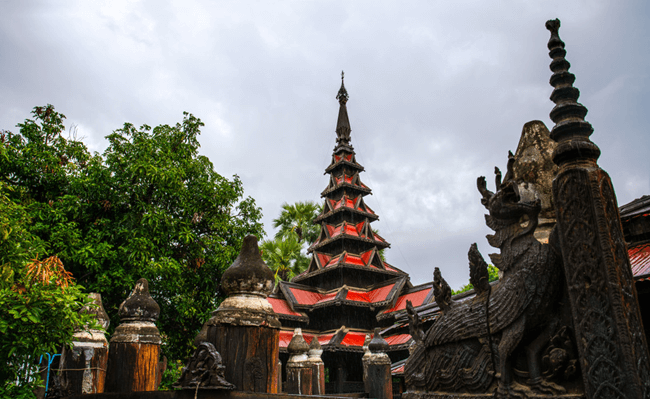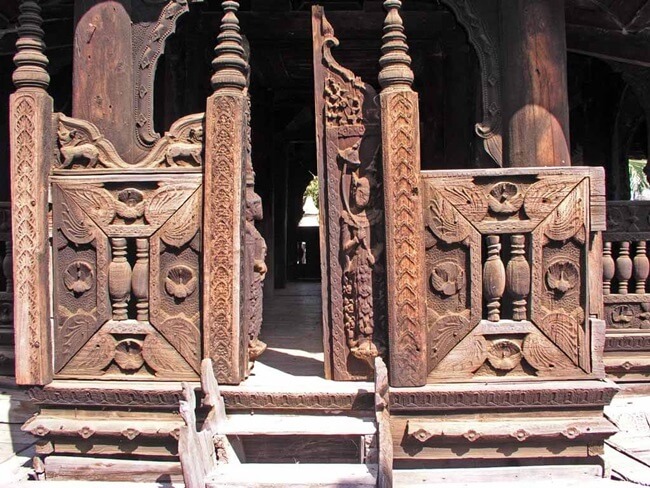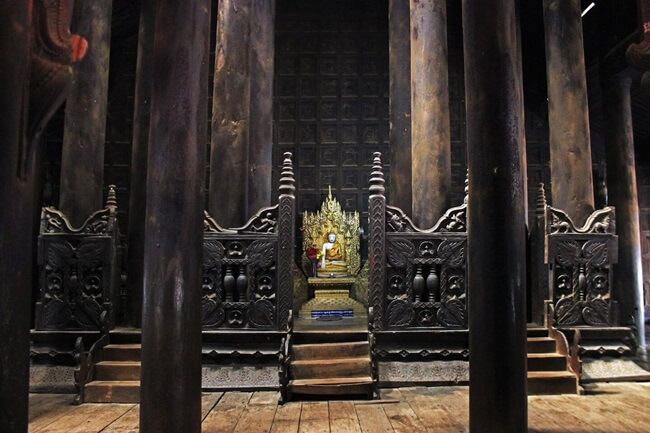Bagaya Monastery – A Wonder of Inwa Architecture
13 Jun 2019 by Admin
Mandalay Region can be considered crucial region for the tourism of Myanmar, particularly in term of historical value. Most of the country’s former capital, such as Mandalay, Bagan, Ava and Amarapura all situated here. For those who want to learn about the ancient era, then the ancient city of Ava (or Inwa as it is called today) might be the best choice. Among the surviving relics of Ava city, the Bagaya Monastery is a site that should not be missed out in your itinerary exploring this ancient place.

Quaint Appearance Of The Monastery
Bagaya is a word in Mon language whose equivalent in the tongue of Burmese is Khayebin, literally means “starflower monastery”. Situated in the southwest of Inwa Palace, about 11km away from Mandalay city, the Monastery is definitely a masterpiece of wood craftsmanship. One of the most appealing characteristics of the monastery is that it is positioned in the heart of a wide paddy field with the charming combination of green bushes and banana trees creating an ideally sheltered foundation to the entire construction.
History of Bagaya Monastery
For every place that we visit, history is the aspect that should not be ignored if you want to know the place in a comprehensive way.The construction of the grand monastery was first implemented in 1953. Later, during the reign of King Hsinbyushin (1763 – 1776), Maha Thiri Zeya Thinkhaya, the town officer of Magwe was ordered to built the monastery in the monastic establishment and made the same dedication to Shin Dhammabhinand.
During the reign of King Bagyidaw (1819 -1837), a great fire broke out and burnt many important buildings, including Bagaya Monastery. Many parts of the monastery were ravaged severely by fire and could no longer be used. In the late twentieth century in 1992, the Government of Myanmar attempted to resurrect the monastery. Therefore, they constructed a new brickwork on the base of the old monastery according to the designing model of the ancient one.
Architecture of Bagaya Monastery
.jpg)
The majestic Bagaya Monastery
Speaking of the architecture of the building, visitors would be surprised at the meticulous and sophisticated structure designed by Burmese architectures more than a thousand years ago. The monastery is a representative for the art of architecture in Inwa Era. The roof of Bagaya Monastery has three tiers and the spire inside the monastery is comprised of seven layers. In the eastern side of the monastery are halls for religious practice like Bhawga Hall and Bhanu Hall.
The whole building lies upon the support of 267 teak posts. The largest teak post has a circumference of approximately 3 meters. All the posts have the same height of about 18 meters. The structure of the monastery is relatively spacious, with the length of roughly 57 meters and the width of 31 meters. Four brick stairs are placed at the entrance leading to Bagaya Monastery.

A Piece Of Carving In Bagaya Monastery
The main modes of decoration that can be seen in this monastery are carvings and floral arabesques. The embellishment with small sculptures and the reliefs of birds and animals, together with small posts on the wall garnished with turnery, the typical form of artistic work in Inwa Era. Huge teak posts standing at the entrance of the monastery are decorated with figurines and reliefs.

A Throne Is Placed Inside The Monastery For Worshiping
A worshipful Buddha statue sitting on a throne is placed in the Marabin, which is a large hall with the separation expanding from the floor to the roof of the monastery. The statue was crafted with the technique of Inwa Era. People visiting Bagaya often come here to pray.
Book a Myanmar River Cruise today to join a luxury trip exploring many other places in the beautiful country of Myanmar.











